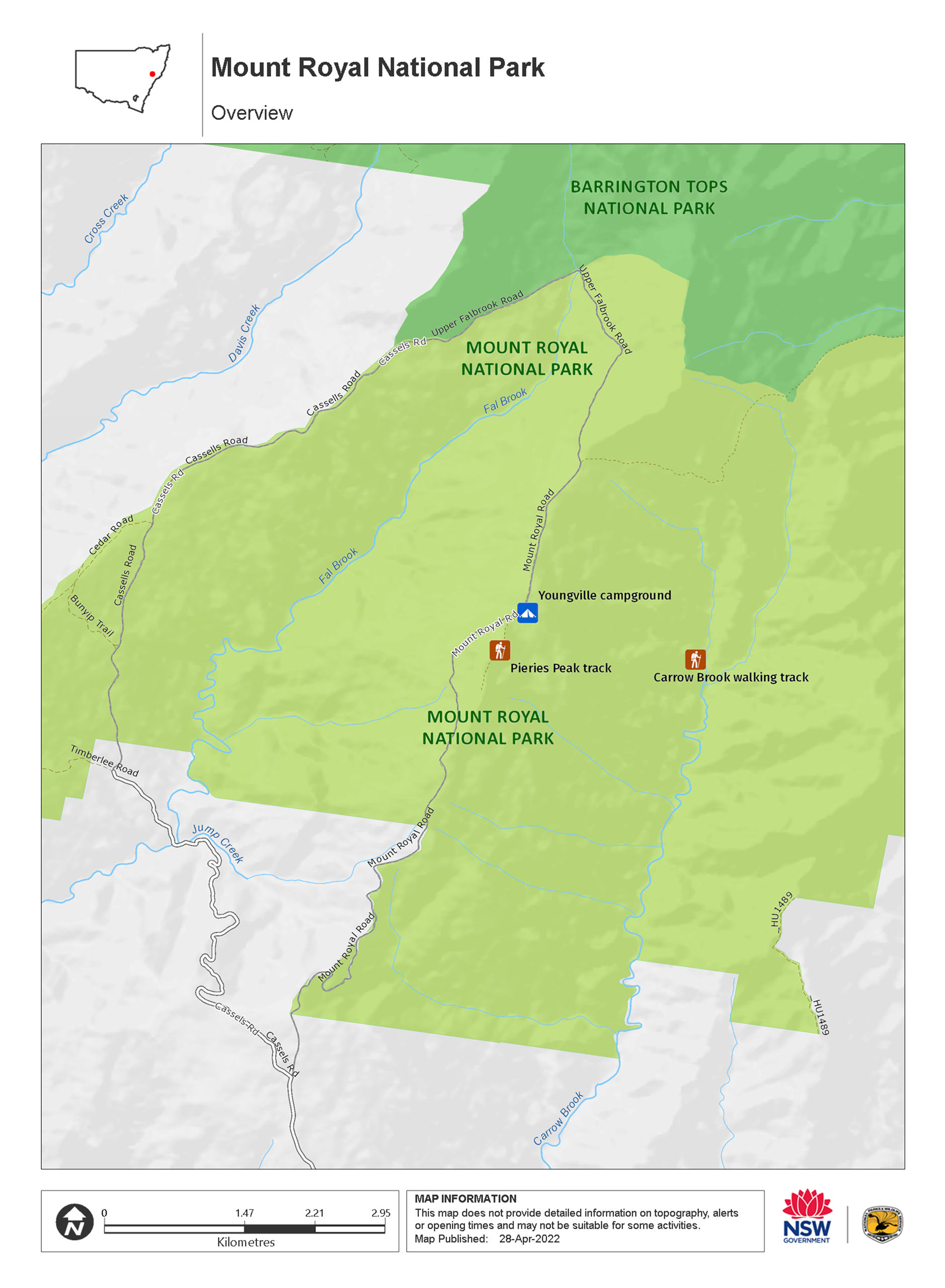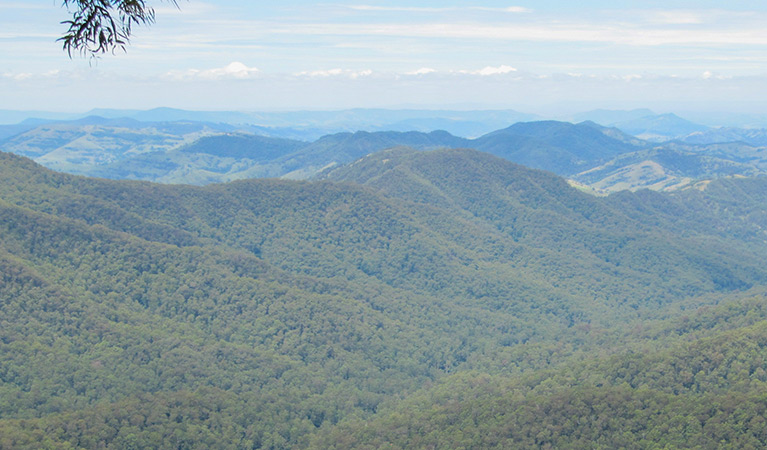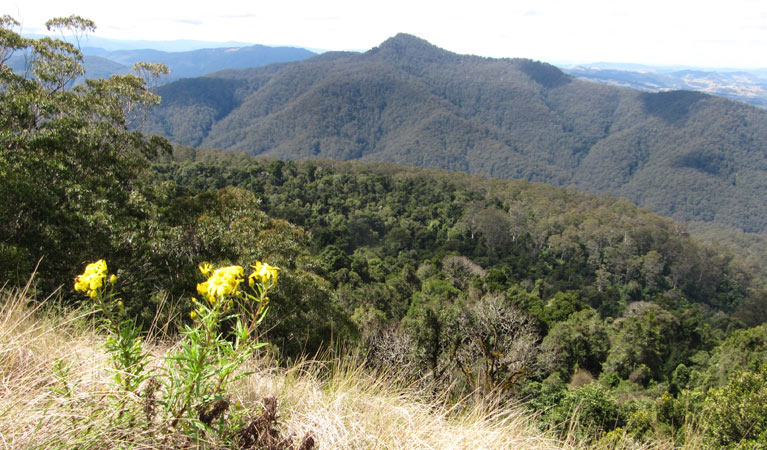Mount Royal National Park
Overview
Camp, hike and picnic in World Heritage-listed Gondwana rainforest at Mount Royal National Park, close to Barrington Tops National Park.
Read more about Mount Royal National Park
Mount Royal National Park is a superb natural environment just waiting to be visited and admired. As part of Gondwana Rainforests of Australia World Heritage Area, the park contains many birds and animals that remain relatively the same as their fossilised ancestors. It’s also home to various threatened and vulnerable species of wildlife such as the Hastings River mouse, parma wallaby, rufous scrub bird and paradise riflebird, and the glossy black-cockatoo.
Come and explore this park. Youngville campground is the ideal base to pitch your tent. Head out from there to see more. Challenging walking tracks lead you to the summit of scenic rock features like Pieries Peak, so bring your hiking boots.
You’ll experience a variety of forest and vegetation types including shrubland, tall open forest, wet eucalypt forest, mid-altitude grassy forest and rainforest.
Local alerts
For the latest updates on fires, closures and other alerts in this area, see https://www.nationalparks.nsw.gov.au/visit-a-park/parks/mount-royal-national-park/local-alerts
Contact
- in the North Coast and Country NSW regions
Mount Royal National Park is always open but may have to close at times due to poor weather or fire danger.
-
-
Bulga office
02 6574 5555
Contact hours: Monday to Friday, 9.30am to 4pm. - 2156 Putty Road, Bulga NSW 2330
-
Email: npws.wollemiyengo@environment.nsw.gov.au
-
Bulga office
Visitor info
All the practical information you need to know about Mount Royal National Park.
Map

Map legend

Maps and downloads
Nearby towns
Singleton (50 km)
Just north of Singleton, at the foot of the Mount Royal Range, Lake St Clair makes a great nature lover's playground. Whether it's swimming, sailing, waterskiing, camping, fishing or picnicking you're after, you'll find it here.
Newcastle (130 km)
Newcastle is a harbour city surrounded by amazing surf beaches that are linked by a great coastal walk, the Bathers Way. The walk from Nobbys Beach to Merewether Beach takes about three hours and is a great way to explore the city.
Learn more
Mount Royal National Park is a special place. Here are just some of the reasons why:
The changing face

After government surveyors explored this area in the very early 1800s, the land soon became mined for gold, logged for its timber and used to graze lifestock. Small settlements established themselves on the plateau, mainly due to these agricultural opportunities. From the early 1900s, however, the area became increasingly popular for recreation and for scientific expeditions.
Same as always

Mount Royal National Park is listed as part of the Gondwana Rainforests of Australia. Formerly known as the Central Eastern Rainforest Reserves, these include the most extensive areas of subtropical rainforest in the world, large areas of warm temperate rainforests and nearly all of the Antarctic beech cool temperate rainforest. Few places on earth contain so many plants and animals that remain relatively unchanged from their ancestors in fossil records.
Safe haven

The rich diversity of vegetation offers habitat for a wide range of birds and animals, many of which are rare and threatened. These include: the endangered hastings river mouse; the threatened parma wallaby (described by British naturalist John Gould way back in 1840 as 'shy' and 'cryptic'; and the vulnerable spotted-tailed quoll, which is the largest marsupial carnivore on mainland Australia. The old growth forest is also habitat for four large forest owls - masked, barking, powerful and sooty - all of which are threatened species. Mount Royal National Park has a variety of forest types and vegetation communities, ranging from shrubland to tall open forest and wet eucalypt forest. The most dominant form of vegetation is mid-altitude grassy forest with plentiful stands of New England blackbutt, Sydney blue gum and grey gum.
- Carrow Brook walking track Carrow Brook walking track is a remote walk into the valleys of Mount Royal National Park, near Singleton. A challenging loop hike, it’s best suited to fit, experienced bushwalkers.
An important cultural place

The area now covered by Mount Royal National Park, Barrington Tops National Park and Barrington Tops State Conservation Area is the traditional land of the Biripi, Worimi, Geawegal, Wonaruah and Ungooroo People. Although these people were dispossessed of their land after European settlement of New South Wales, they continue to have a deep attachment to the country and an active interest in its management. This place contains important foods, medicinal plants, animal species and sacred sites.
Education resources (1)
What we're doing
Mount Royal National Park has management strategies in place to protect and conserve the values of this park. View the detailed park and fire management documents.

